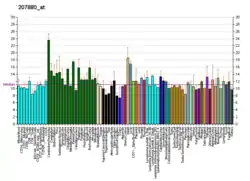ADAM11
Disintegrin and metalloproteinase domain-containing protein 11 is an enzyme that in humans is encoded by the ADAM11 gene.[5][6]
| ADAM11 | |||||||||||||||||||||||||
|---|---|---|---|---|---|---|---|---|---|---|---|---|---|---|---|---|---|---|---|---|---|---|---|---|---|
| Identifiers | |||||||||||||||||||||||||
| Aliases | ADAM11, MDC, ADAM metallopeptidase domain 11 | ||||||||||||||||||||||||
| External IDs | OMIM: 155120 MGI: 1098667 HomoloGene: 7614 GeneCards: ADAM11 | ||||||||||||||||||||||||
| |||||||||||||||||||||||||
| |||||||||||||||||||||||||
| |||||||||||||||||||||||||
| |||||||||||||||||||||||||
| Orthologs | |||||||||||||||||||||||||
| Species | Human | Mouse | |||||||||||||||||||||||
| Entrez | |||||||||||||||||||||||||
| Ensembl | |||||||||||||||||||||||||
| UniProt | |||||||||||||||||||||||||
| RefSeq (mRNA) | |||||||||||||||||||||||||
| RefSeq (protein) | |||||||||||||||||||||||||
| Location (UCSC) | Chr 17: 44.76 – 44.78 Mb | Chr 11: 102.76 – 102.78 Mb | |||||||||||||||||||||||
| PubMed search | [3] | [4] | |||||||||||||||||||||||
| Wikidata | |||||||||||||||||||||||||
| |||||||||||||||||||||||||
This gene encodes a member of the ADAM (a disintegrin and metalloprotease) protein family. Members of this family are membrane-anchored proteins structurally related to snake venom disintegrins, and have been implicated in a variety of biological processes involving cell-cell and cell-matrix interactions, including fertilization, muscle development, and neurogenesis. This gene represents a candidate tumor suppressor gene for human breast cancer based on its location within a minimal region of chromosome 17q21 previously defined by tumor deletion mapping.[6]
References
- GRCh38: Ensembl release 89: ENSG00000073670 - Ensembl, May 2017
- GRCm38: Ensembl release 89: ENSMUSG00000020926 - Ensembl, May 2017
- "Human PubMed Reference:". National Center for Biotechnology Information, U.S. National Library of Medicine.
- "Mouse PubMed Reference:". National Center for Biotechnology Information, U.S. National Library of Medicine.
- Emi M, Katagiri T, Harada Y, Saito H, Inazawa J, Ito I, Kasumi F, Nakamura Y (Jan 1994). "A novel metalloprotease/disintegrin-like gene at 17q21.3 is somatically rearranged in two primary breast cancers". Nat Genet. 5 (2): 151–7. doi:10.1038/ng1093-151. PMID 8252040. S2CID 11770397.
- "Entrez Gene: ADAM11 ADAM metallopeptidase domain 11".
Further reading
- Wolfsberg TG, Primakoff P, Myles DG, White JM (1995). "ADAM, a novel family of membrane proteins containing A Disintegrin And Metalloprotease domain: multipotential functions in cell-cell and cell- matrix interactions". J. Cell Biol. 131 (2): 275–8. doi:10.1083/jcb.131.2.275. PMC 2199973. PMID 7593158.
- Katagiri T, Harada Y, Emi M, Nakamura Y (1994). "Human metalloprotease/disintegrin-like (MDC) gene: exon-intron organization and alternative splicing". Cytogenet. Cell Genet. 68 (1–2): 39–44. doi:10.1159/000133884. PMID 7956356.
- Sagane K, Ohya Y, Hasegawa Y, Tanaka I (1998). "Metalloproteinase-like, disintegrin-like, cysteine-rich proteins MDC2 and MDC3: novel human cellular disintegrins highly expressed in the brain". Biochem. J. 334 ( Pt 1) (Pt 1): 93–8. doi:10.1042/bj3340093. PMC 1219666. PMID 9693107.
- Hartley JL, Temple GF, Brasch MA (2001). "DNA Cloning Using In Vitro Site-Specific Recombination". Genome Res. 10 (11): 1788–95. doi:10.1101/gr.143000. PMC 310948. PMID 11076863.
- Strausberg RL, Feingold EA, Grouse LH, et al. (2003). "Generation and initial analysis of more than 15,000 full-length human and mouse cDNA sequences". Proc. Natl. Acad. Sci. U.S.A. 99 (26): 16899–903. doi:10.1073/pnas.242603899. PMC 139241. PMID 12477932.
- Hillman RT, Green RE, Brenner SE (2005). "An unappreciated role for RNA surveillance". Genome Biol. 5 (2): R8. doi:10.1186/gb-2004-5-2-r8. PMC 395752. PMID 14759258.
- Brandenberger R, Wei H, Zhang S, et al. (2005). "Transcriptome characterization elucidates signaling networks that control human ES cell growth and differentiation". Nat. Biotechnol. 22 (6): 707–16. doi:10.1038/nbt971. PMID 15146197. S2CID 27764390.
- Fu GK, Wang JT, Yang J, et al. (2005). "Circular rapid amplification of cDNA ends for high-throughput extension cloning of partial genes". Genomics. 84 (1): 205–10. doi:10.1016/j.ygeno.2004.01.011. PMID 15203218.
External links
- The MEROPS online database for peptidases and their inhibitors: M12.976
- Human ADAM11 genome location and ADAM11 gene details page in the UCSC Genome Browser.
This article is issued from Wikipedia. The text is licensed under Creative Commons - Attribution - Sharealike. Additional terms may apply for the media files.




